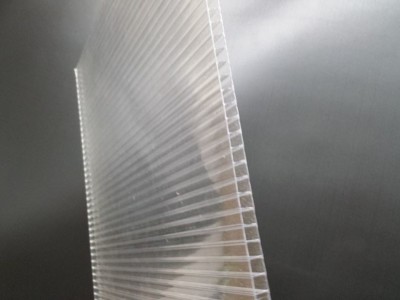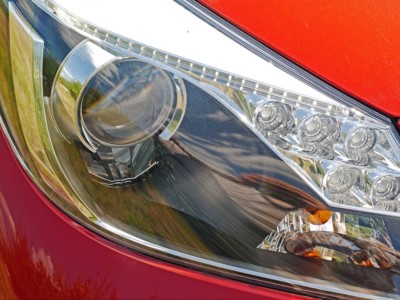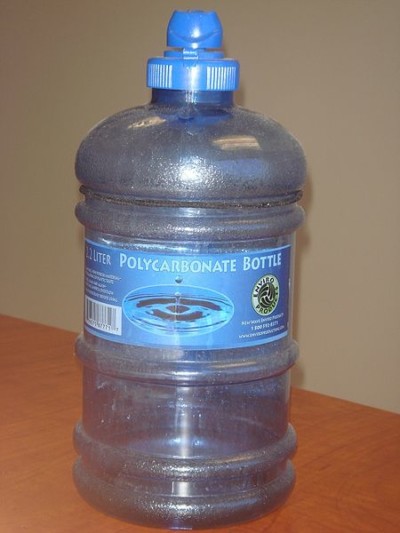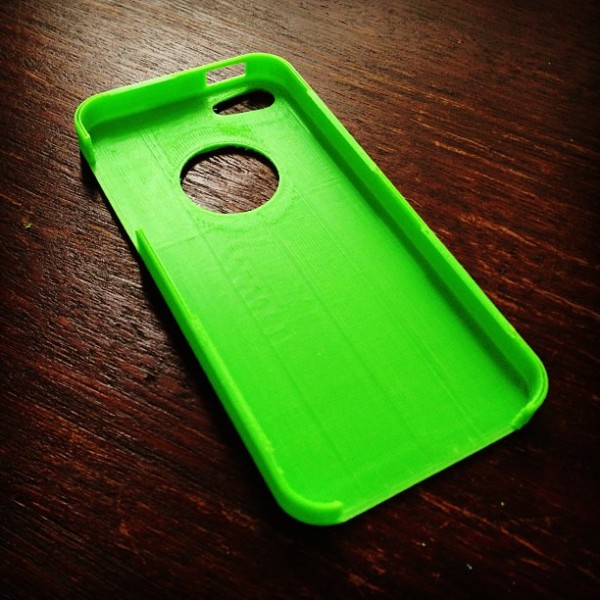The strong mechanical properties of polycarbonate make it useful for a variety of applications and have led to its frequent use in many industries. It is most recognized for its use as food containers and bulletproof glass.
In this article, we’ll discuss what polycarbonate is, its common applications, the challenges to manufacturing and 3D printing polycarbonate, and possible alternative materials.
What is Polycarbonate?
 Polycarbonate is an amorphous thermoplastic that is widely used because of its high-performance mechanical properties that surpass many other thermoplastic materials. These properties include:
Polycarbonate is an amorphous thermoplastic that is widely used because of its high-performance mechanical properties that surpass many other thermoplastic materials. These properties include:
- High tensile strength & flexural strength
- High heat resistance
- Flame retardant
- High impact resistance
- Lightweight
- Good insulation
- BPA-free grades available
- Optical clarity similar to glass (can be made to be colored, translucent, or clear)
While it possesses many excellent properties, polycarbonate has some drawbacks as well. It is hygroscopic, so it must be stored in a dry, airtight container to avoid absorbing moisture from the air. If exposed to water, it may lead to hydrolysis, which means the bonds of the material’s molecules will weaken. This can degrade the strength of the material, and polycarbonate may release Bisphenol A (BPA), a chemical that can be harmful in large amounts. Polycarbonate can also be hard to manufacture because it may easily warp and has a high glass transition temperature of 302°F, meaning that temperatures must be kept high during production to ensure proper melting and maintained to prevent distortion.
Still, these problems are outweighed by polycarbonates’s advantages, which is why it is widely used across many industries. The primary industries where polycarbonate is used include electrical, automotive, safety, construction, and consumer goods.
 Electrical & Automotive
Electrical & Automotive
Due to excellent flame retardancy and heat resistance, as well as being lightweight and a great insulator, polycarbonate is safe for applications in the electrical and automotive industries, including electrical housings and fixtures. A common use for vehicles is headlights. However, polycarbonate used for vehicles must be coated to prevent yellowing from prolonged exposure to UV light and protect from common automotive and environmental fluid contact. This coating also helps reduce the possibility of scratches because polycarbonate has a very low scratch resistance.
Safety & Construction
Polycarbonate can be clear and does not shatter like regular glass or plexiglass, making it ideal for protective applications. It most often finds use in the safety and construction industries as safety goggles and windows.
 Consumer Goods
Consumer Goods
Although polycarbonate may release BPA, it is commonly used for water bottles, food containers, and other culinary items. Sometimes, BPA-free grades of polycarbonate are used for this purpose, as is PC-ISO, which is certified for biocompatible use in the medical field. The slight flex and optical clarity of polycarbonate also finds use as sunglasses and phone cases. Many data storage devices, such as CDs, DVDs, and Blu-Ray discs, are made from polycarbonate as well.
Manufacturing with PC
Polycarbonate is most often mass-produced via traditional manufacturing methods, such as machining and injection molding. These methods involve expensive tooling costs but are great for quick, high volume productions.
When machining polycarbonate, it is important that sharp tools and sufficient coolant are used to prevent cracks and heat build up in the part. Post-processing care is especially important because polycarbonate may be susceptible to cracks if not properly annealed after machining. Most machined polycarbonate parts will not be fully transparent upon completion and will need the surface finished with either buffing, vapor smoothing, or manual polishing. Erasing the microscopic marks from the tooling will restore the material’s transparency.
Injection molding polycarbonate also requires certain care to achieve satisfactory parts. Polycarbonate has a high viscosity and, as such, may have trouble filling the entire mold if the part is large or has thin walls. To compensate for this, a higher injection pressure must be used. While there are grades of polycarbonate available that have a lower viscosity, these will produce weaker parts. Another factor to keep in mind is that polycarbonate is likely to warp and cannot be allowed to cool prematurely, so the mold should be kept at a constant temperature.
3D Printing with Polycarbonate
In addition to traditional manufacturing methods, polycarbonate can also be produced via filament extrusion 3D printing. This process involves melting 3D printing filament and extruding it onto a build platform layer by layer to construct a part. It is best suited for low volume production. Successfully printing polycarbonate filament can be a challenge, and the best results are achieved with industrial FDM 3D printers. However, it can still be difficult to produce strong, quality parts this way without first taking several precautions.
 The primary factor to consider when 3D printing polycarbonate is the high temperatures at which the printer must operate. To properly melt polycarbonate 3D printer filament, the extruder’s nozzle will need to be all metal to sustain a 500-590°F temperature range. Additionally, it is best to have an enclosed and heated bed with a constant printing bed temperature of about 230°F. This allows the build chamber to maintain an even printing temperature and prevents the material from cooling too quickly, which can cause warping and layer delamination and result in weak parts. Some grades of polycarbonate can have additives included so that PC filament may be printed at a lower temperatures, but this is not recommended as this reduces the strength of the printed part.
The primary factor to consider when 3D printing polycarbonate is the high temperatures at which the printer must operate. To properly melt polycarbonate 3D printer filament, the extruder’s nozzle will need to be all metal to sustain a 500-590°F temperature range. Additionally, it is best to have an enclosed and heated bed with a constant printing bed temperature of about 230°F. This allows the build chamber to maintain an even printing temperature and prevents the material from cooling too quickly, which can cause warping and layer delamination and result in weak parts. Some grades of polycarbonate can have additives included so that PC filament may be printed at a lower temperatures, but this is not recommended as this reduces the strength of the printed part.
In addition to temperature control playing a part in polycarbonate 3D printing quality, bed adhesion and pre-drying of the filament must also be taken into account. Polycarbonate often does not adhere well to build platforms, which may result in warping. While having adhesion solutions or other materials serve as anchor are common suggestions to help avoid this problem, this can make the print messy and more difficult because those materials may melt under the high temperatures required to produce the polycarbonate correctly.
Furthermore, polycarbonate filament must be dried prior to use. Polycarbonate is likely to ooze during printing regardless, but if wet filament is printed, bubbles and popping can occur and create a messy part. Printing wet filament can also cause hydrolysis to occur. Another way to combat ooze and messy prints is to set the printing speed based on the printing temperature you are using. It is best to print at 30-60 mm/sec, and lower speed allows for more control of the filament.
Polycarbonate Alternatives
As with all parts, it is important to consider the intended use when selecting material. Polycarbonate may be more than sufficient for some applications, so other materials may prove to be more beneficial for your production. Additionally, there are a few alternatives that offer higher strength and heat resistance if your part will be used in more demanding conditions.
 1. ABS
1. ABS
If your part does not require the higher durability of polycarbonate to function properly, ABS may be a viable alternative. ABS is easy to manufacture and is used widely in a variety of industries, which makes it more affordable than most other thermoplastics. It has good impact and heat resistance that will provide satisfactory results in most environments.
2. ULTEM
ULTEM is a type of Polyetherimide thermoplastic that performs well in tough environments, including high heat and outdoor applications. It is heat, flame, solvent, and UV resistant, among many other beneficial mechanical properties that have led to its frequent use in the aerospace and automotive industries. It is also better suited for sterilization and biocompatible purposes than polycarbonate.
3. PPSF
While not as strong as ULTEM, PPSF is still more durable than polycarbonate. It is especially suited for high heat environments as it is self-extinguishing and has a glass transition temperature of 446°F. It may be exposed to high friction or open flames with much more reliability than polycarbonate or ULTEM.
3D Printing at 3 Space
Here at 3 Space, we offer a wide variety of 3D printing materials, including polycarbonate, ABS, ULTEM, and PPSF. Our engineers are experts in these materials and can answer any questions you have regarding which material may be best suited for your part. For more information, contact us today.
